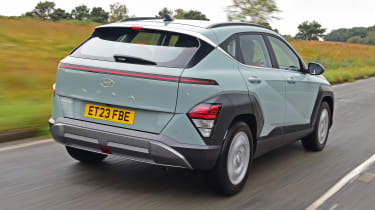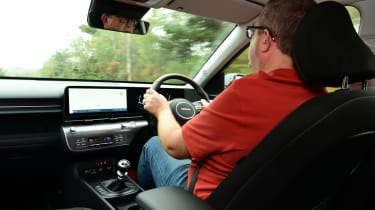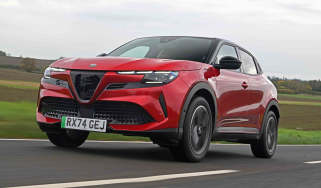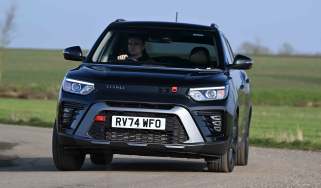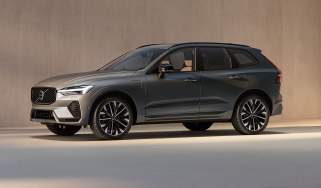Hyundai Kona Advance 1.0 petrol review
The entry-level Hyundai Kona misses out on some tech and performance but feels none the worse for it at what is a temptingly low price

Verdict
Well equipped, decent to drive and almost reassuringly simple, the entry-level Kona petrol is a very capable all rounder which retains the qualities that earned its pricier stablemates our top award. It should be at the sharp end of your shortlist if you’re in the market for a small family SUV.
The second generation of Hyundai Kona made a strong impression on us when it was revealed in the spring; indeed, its combination of improved space, big-car technology and a mix of powertrains secured it our outright Car of the Year gong back in the summer. Hyundai has been padding out the range ever since, and now’s our first chance to try the starting point: the entry-level petrol Hyundai Kona.
And this really is a baseline. The car gets a very different look in Advance trim, with its chunky grey body cladding, from that of the top-spec Kona Electric - as well as a more humble powertrain. Instead of the big battery and electric motor you get a 1.0-litre three-cylinder turbocharged petrol engine, producing 118bhp at a heady 6,000rpm and 172Nm of torque. There isn’t even mild-hybrid assistance to help it along, like there used to be on the i20 supermini (the option has been dropped on that model too, incidentally).
Hyundai claims a relatively leisurely 0-62mph time of 11.8 seconds and combined fuel consumption of 48.7mpg, with CO2 emissions of 131g/km. So this is a world away from even the more potent petrol Konas, let alone the electric flagship.
Used - available now
But here’s the thing: it doesn’t feel like the poor relation when you’re driving it. In fact the Kona 1.0 is rather sweet, helped by 17-inch wheels wrapped in chunky 215/60-profile tyres. If anything, there’s more compliance in this car than in higher-end editions, helped further, no doubt, by the fact that it weighs a few hundred kilos less than those carrying hefty EV batteries. There’s some body roll in corners, but actually throw the thing towards an apex and you’ll feel a very progressive transition between leaning on those tall sidewalls and actually breaking traction to push wide. It’s not exactly fun, but it is safe and predictable.
The 1.0 feels quicker than its raw numbers suggest, too – never anything approaching properly fast, but equally, always pretty comfortable with its own size and weight. There’s a six-speed manual gearbox as standard and it has a pleasingly accurate and relatively short throw; we wish it had the old i20 mild hybrid’s trick of turning off its engine while you’re cruising along, just for a slight increase in efficiency, but the engine’s still barely hitting 2,000rpm when you’re at a fast motorway pace. And at that point a bit of wind rush is probably the worst intrusion you’re going to experience.
The mature driving experience is completed by a cabin that is, of course, every bit as spacious as in other Konas – a proper smally family SUV, in a way that the first-gen model could never manage. There’s space for four grown-ups on board and the boot capacity is 466 litres, or 1,300 litres if you fold down the back seats. Those numbers look competitive against all but the most capacious family hatchbacks.
The interior finish itself is a little less flash in the entry spec but, hard door armrests aside, there’s padding in most of the key areas, and everywhere you might prod or press feels reassuringly well made.
Advance trim has an alarming number of blanked-off buttons at either side of the gear stick, but it still manages to tick almost all of the right boxes on spec. You get front and rear parking sensors, a rear-view camera, dual-zone air conditioning, a pair of 12.3-inch displays (one for the instruments, one for the infotainment and standard navigation one), four USB-C ports, LED headlights and tail-lights, and cruise control. The onboard interfaces are easy to use and quick to respond, and Hyundai has wisely seen fit to include conventional heating and ventilation controls on the metallic panel beneath the widescreen infotainment panel.
You’ll have to opt for N Line if you fancy heated seats, though; they’re not even available as an option on Advance, which has only a single possible add-on: metallic paint, beyond the standard Mirage Green of the car pictured here.
Even so, and perhaps even more than the Kona Electric, this feels like a load of sophisticated small SUV for less than £26k. Hyundai has already slung a £1,000 deposit contribution behind its finance offers too, so putting down £4,400 brings monthly payments in at just over £300 (three-year deal, 10,000 miles per year). It’s not as affordable as some – notably Peugeot’s revamped 2008 – but it’s certainly in the same ballpark as the likes of the Ford Puma.
| Model: | Hyundai Kona Advance 1.0T 120PS manual |
| Price: | £25,725 |
| Engine: | 1.0-litre 3cyl turbo petrol |
| Power/torque: | 118bhp/172Nm |
| Transmission: | Six-speed manual, four-wheel drive |
| 0-62mph: | 11.8 seconds |
| Top speed: | 112mph |
| Economy: | 48.7mpg |
| CO2 emissions: | 131g/km |
| Dimensions (l/w/h): | 4,350/1,825/1,575mm |
| On sale: | Now |


